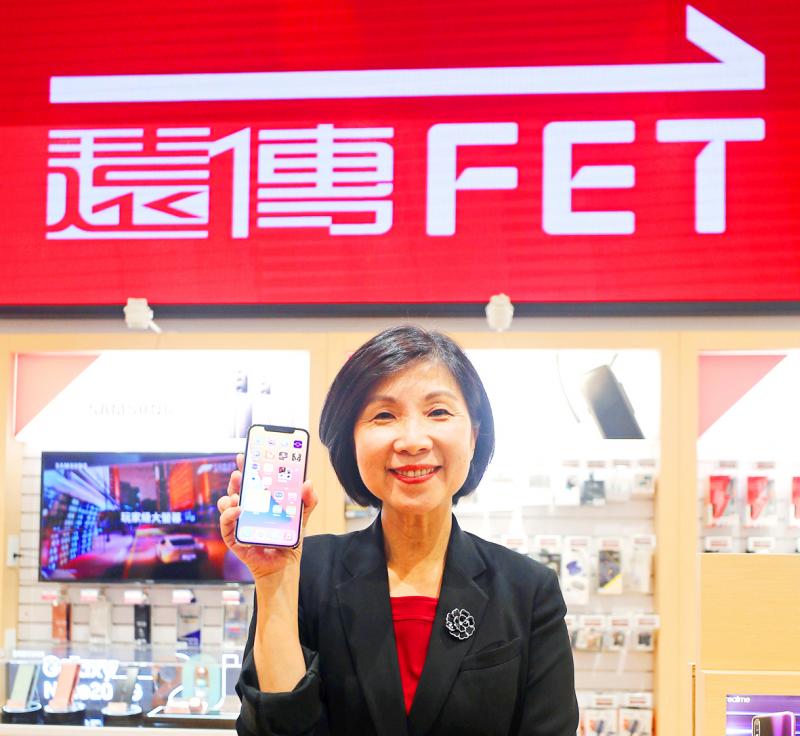Far EasTone Telecommunications Co (遠傳電信) yesterday said it has signed an agreement with Asia Pacific Telecom Co (亞太電信) to extend their collaboration in 5G spectrum sharing to 4G networks.
Based on the agreement, Far EasTone would share 25 megahertz of its 700 megahertz (MHz) band with Asia Pacific Telecom for 20 years.
The spectrum is used by telecoms to offer 4G services.

Photo: CNA
The two firms are to share costs for the spectrum, as well as network deployment expenses.
The transaction is subject to the approval of the National Communications Commission (NCC), Far EasTone said.
The NCC has rules that allow 5G spectrum sharing, but ban 4G spectrum sharing.
The partnership came after Far EasTone on Sept. 4 announced that it planned to pay up to NT$5 billion (US$173.17 million) to acquire an 11.58 percent stake in Asia Pacific Telecom through a private placement as part of a plan to share 5G spectrum on the 3.5 gigahertz (GHz) band.
“We are looking to share that spectrum in addition to the 3.5GHz 5G sharing,” Far EasTone president Chee Ching (井琪) told investors at a teleconference.
“That [700MHz spectrum sharing] is very useful and efficient to improve our spectrum performance not only for 4G, but also 5G, for indoor penetration,” Ching said. “This will be a powerful addition to our already premium spectrum for 5G.”
If the NCC bans the sharing of 700MHz spectrum, Far EasTone plans to trade 5MHz of its 2.6GHz band for Asia Pacific Telecom’s 700MHz band, she said.
Commenting on Far EasTone’s progress in converting its 4G subscribers to 5G services, Ching said: “We are ahead of our target.”
More than 300,000 people using 4G services are expected to switch to 5G services before the end of this year, Ching said.
Far EasTone aims to deploy 4,000 5G base stations by the end of the year, she said.
The company hopes to boost its 5G penetration to 20 percent within a year of the launch of 5G services, she said.
Far EasTone said that 5G subscriptions have boosted its average revenue per user (ARPU) and the effect is magnifying following the launch of the 5G-enabled iPhone 12 series.
More than 97 percent of iPhone 12 buyers signed up for a high-rate plan, starting at NT$999, it said.
In the first three quarters, Far EasTone’s net profit was NT$6.47 billion, or earnings per share (EPS) of NT$1.99, beating its forecast of NT$6.15 billion.
That represented about a 1.97 percent decline from net profit of NT$6.6 billion, or EPS of NT$2.03, in the first three quarters of last year.
Revenue was NT$60.9 billion in the first three quarters, down 2.79 percent from NT$62.65 billion in the same period last year.

Among the rows of vibrators, rubber torsos and leather harnesses at a Chinese sex toys exhibition in Shanghai this weekend, the beginnings of an artificial intelligence (AI)-driven shift in the industry quietly pulsed. China manufactures about 70 percent of the world’s sex toys, most of it the “hardware” on display at the fair — whether that be technicolor tentacled dildos or hyper-realistic personalized silicone dolls. Yet smart toys have been rising in popularity for some time. Many major European and US brands already offer tech-enhanced products that can enable long-distance love, monitor well-being and even bring people one step closer to

Malaysia’s leader yesterday announced plans to build a massive semiconductor design park, aiming to boost the Southeast Asian nation’s role in the global chip industry. A prominent player in the semiconductor industry for decades, Malaysia accounts for an estimated 13 percent of global back-end manufacturing, according to German tech giant Bosch. Now it wants to go beyond production and emerge as a chip design powerhouse too, Malaysian Prime Minister Anwar Ibrahim said. “I am pleased to announce the largest IC (integrated circuit) Design Park in Southeast Asia, that will house world-class anchor tenants and collaborate with global companies such as Arm [Holdings PLC],”

TRANSFORMATION: Taiwan is now home to the largest Google hardware research and development center outside of the US, thanks to the nation’s economic policies President Tsai Ing-wen (蔡英文) yesterday attended an event marking the opening of Google’s second hardware research and development (R&D) office in Taiwan, which was held at New Taipei City’s Banciao District (板橋). This signals Taiwan’s transformation into the world’s largest Google hardware research and development center outside of the US, validating the nation’s economic policy in the past eight years, she said. The “five plus two” innovative industries policy, “six core strategic industries” initiative and infrastructure projects have grown the national industry and established resilient supply chains that withstood the COVID-19 pandemic, Tsai said. Taiwan has improved investment conditions of the domestic economy

MAJOR BENEFICIARY: The company benefits from TSMC’s advanced packaging scarcity, given robust demand for Nvidia AI chips, analysts said ASE Technology Holding Co (ASE, 日月光投控), the world’s biggest chip packaging and testing service provider, yesterday said it is raising its equipment capital expenditure budget by 10 percent this year to expand leading-edge and advanced packing and testing capacity amid strong artificial intelligence (AI) and high-performance computing chip demand. This is on top of the 40 to 50 percent annual increase in its capital spending budget to more than the US$1.7 billion to announced in February. About half of the equipment capital expenditure would be spent on leading-edge and advanced packaging and testing technology, the company said. ASE is considered by analysts